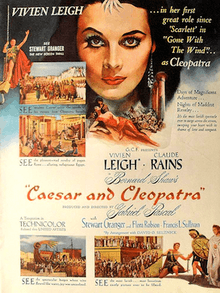Caesar and Cleopatra (film)
| Caesar and Cleopatra | |
|---|---|
 theatrical release poster | |
| Directed by | Gabriel Pascal |
| Produced by | Gabriel Pascal |
| Written by |
George Bernard Shaw (play {uncredited}, scenario and dialogue) |
| Starring |
Claude Rains Vivien Leigh |
| Music by | Georges Auric |
| Cinematography |
F. A. Young F.R.P.S. Robert Krasker Jack Hildyard Jack Cardiff |
| Edited by |
Frederick Wilson Joan Warwick (uncredited) |
Production company | |
| Distributed by |
Eagle-Lion Films (UK) United Artists (US) |
Release date |
11 December 1945 (London) 6 September 1946 {US} 16 September 1946 (UK) |
Running time |
128 minutes (UK) 123 minutes (US) |
| Country | United Kingdom |
| Language | English |
| Budget | $5.2 million[1] or £1.3 million[2][3] |
| Box office |
$2,250,000 (US rentals)[4] 815,007 admissions (France)[5] $1.4 million (UK)[3] |
Caesar and Cleopatra is a 1945 British Technicolor film directed by Gabriel Pascal and starring Claude Rains and Vivien Leigh.[6] Some scenes were directed by Brian Desmond Hurst who took no formal credit. It was adapted from the play Caesar and Cleopatra (1901) by George Bernard Shaw. The film was produced by Independent Producers and Pascal Film Productions, and was distributed by Eagle-Lion Distributors. St6aff (30 October 1946)
Caesar and Cleopatra was a box office failure, but it was nominated for an Academy Award for Best Art Direction for John Bryan.[7]
Plot
In this philosophical coming-of-age film, an aging Julius Caesar takes possession of the Egyptian capital city of Alexandria, and tries to resolve a feud between young Princess Cleopatra and her younger brother Ptolemy. During the resulting sometimes-murderous court intrigues, Caesar develops a special relationship with Cleopatra, and teaches her how to use her royal power.
Cast
- Claude Rains as Caesar
- Vivien Leigh as Cleopatra
- Stewart Granger as Apollodorus
- Flora Robson as Ftatateeta
- Francis L. Sullivan as Pothinus
- Basil Sydney as Rufio
- Cecil Parker as Britannus
- Raymond Lovell as Lucius Septimus
- Anthony Eustrel as Achillas
- Ernest Thesiger as Theodotus
- Anthony Harvey as Ptolemy
- Robert Adams as Nubian Slave
- Olga Edwardes
- Harda Swanhilde as Cleopatra's Lady Attendants
- Michael Rennie as 1st. Centurion
- James McKechnie as 2nd. Centurion
- Esme Percy as Major Domo
- Stanley Holloway as Belzanor
- Leo Genn as Bel Affris
- Alan Wheatley as Persian
- Anthony Holles as Boatman
- Charles Victor as 1st. Porter
- Ronald Shiner as 2nd. Porter
- John Bryning as Sentinel
- John Laurie as 1st. Auxiliary Sentinel
- Charles Rolfe as 2nd. Auxiliary Sentinel
- Felix Aylmer as 1st. Nobleman
- Ivor Barnard as 2nd. Nobleman
- Valentine Dyall as 1st. Guardsman
- Charles Deane as 2nd. Guardsman
- Uncredited cast members (alphabetically)
- Renée Asherson as Iras
- Marie Ault as Egyptian Lady
- Peter Bayliss as Aide to Mithridates
- Mihalis Kakogiannis as Councillor
- Kay Kendall as Slave Girl
- Zena Marshall as Lady-in-Waiting
- Roger Moore as Extra
- Cathleen Nesbitt as Egyptian Lady
- Charles Paton as Councillor
- Jean Simmons as harpist
Production
Filmed in Technicolor with lavish sets, the production was reported to be the most expensive film ever made in Britain at the time, costing £1,278,000.[8]
Pascal ordered sand from Egypt to get the right cinematic color. The production also ran into delays due to being filmed during the Second World War.[9] During the shoot, Vivien Leigh tripped and miscarried her pregnancy from husband Laurence Olivier. This incident offset Leigh's manic depression, initiating an emotional breakdown in her and halting production for five weeks.[1]
The film was described as a "box office stinker" at the time, and almost ended Pascal's career. It was the first Shaw film made in colour, and the last film version of a Shaw play during his lifetime. After Shaw's death in 1950, Pascal went on to produce one more Shaw-derived film, Androcles and the Lion in 1952.
Reception
According to trade papers, the film was a "notable box office attraction" at British cinemas.[10]
The film earned $1,363,371 in the United States, making it one of the most popular British films ever released there.[11] It did however fall short of initial expectations. Variety estimated that Rank lost $3 million on the film.[3]
See also
References
Notes
- 1 2 Steinberg, Jay S. "Caesar and Cleopatra" (article) TCM.com
- ↑ "The London Letter: Loan Vote Prospects" The Scotsman [Edinburgh, Scotland] 13 Dec 1945: 4.
- 1 2 3 Staff (30 October 1946) "'Cleo' $3,000,000 in the red", Variety (magazine)|Variety, p.3
- ↑ Staff (8 January 1947) "60 Top Grossers of 1946" Variety (maagazine)|Variety p,8
- ↑ Box office information for Stewart Granger films in France at Box Office Story
- ↑ "Caesar and Cleopatra (1945)". Retrieved 1 August 2018.
- ↑ "946 (19th) Art Direction (Color) Caesar and Cleopatra John Bryan"
- ↑ "Noteworthy Films Made In U.K." The West Australian. Perth: National Library of Australia. 17 January 1953. p. 27. Retrieved 4 August 2012.
- ↑ "Caesar and Cleopatra" (1945) home video review, TCM.com
- ↑ Murphy, Robert (2003) Realism and Tinsel: Cinema and Society in Britain 1939-48 p.209
- ↑ Street, Sarah (2002) Transatlantic Crossings: British Feature Films in the USA, Continuum, p.94
Bibliography
- Vermilye, Jerry. (1978) The Great British Films, Citadel Press, pp. 97–101. ISBN 0-8065-0661-X
External links
- Caesar and Cleopatra at the British Film Institute
- Caesar and Cleopatra on IMDb
- Caesar and Cleopatra at Rotten Tomatoes
- Caesar and Cleopatra at the TCM Movie Database
- Caesar and Cleopatra at AllMovie
- Movie Production Stills 1
- Movie Production Stills 2
- Trailer for Caesar and Cleopatra (Video)
- Gabriel Pascal directs Shaw's 'Caesar and Cleopatra' 1945 on YouTube (Newsreel)
- Film Facts
- Pascal with Jean Simmons at premiere 13 December 1945